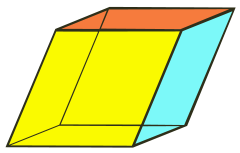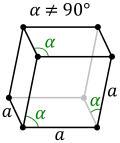Rhombohedron
| Rhombohedron | |
|---|---|
 | |
| Type | Prism |
| Faces | 6 rhombi |
| Edges | 12 |
| Vertices | 8 |
| Symmetry group | Ci, [2+,2+], (×), Order 2 |
| Properties | convex, zonohedron |
In geometry, a rhombohedron is a three-dimensional figure like a cube, except that its faces are not squares but rhombi. It is a special case of a parallelepiped where all edges are the same length. It can be used to define the rhombohedral lattice system, a honeycomb with rhombohedral cells.
In general the rhombohedron can have three types of rhombic faces in congruent opposite pairs, Ci symmetry, order 2.
Four points forming non-adjacent vertices of a rhombohedron necessarily form the four vertices of an orthocentric tetrahedron, and all orthocentric tetrahedra can be formed in this way.[1]
Rhombohedral lattice system
The rhombohedral lattice system has rhombohedral cells, with 3 pairs of unique rhombic faces:
Special cases
| Form | Cube | Trigonal trapezohedron | Right rhombic prism | General rhombic prism | General rhombohedron |
|---|---|---|---|---|---|
| Symmetry | Oh, [4,3], order 48 | D3d, [2+,6], order 12 | D2h, [2,2], order 8 | C2h, [2], order 4 | Ci, [2+,2+], order 2 |
| Image |  |
 |
 | ||
| Faces | 6 squares | 6 identical rhombi | Two rhombi and 4 squares | 6 rhombic faces | 6 rhombic faces |
- Cube: with Oh symmetry, order 48. All faces are squares.
- Trigonal trapezohedron: with D3d symmetry, order 12. If all of the non-obtuse internal angles of the faces are equal (all faces are same). This can be see by stretching a cube on its body-digonal axis. For example, a regular octahedron with two tetrahedra attached on opposite faces constructs a 60 degree trigonal trapezohedron:.
- Right rhombic prism: with D2h symmetry, order 8. It constructed by two rhombi and 4 squares. This can be see by stretching a cube on its face-digonal axis. For example, two triangular prisms attached together makes a 60 degree rhombic prism.
- A general rhombic prism: With C2h symmetry, order 4. It has only one plane of symmetry through four vertices, and 6 rhombic faces.
Solid Geometry
For a unit rhombohedron[2] (side length = 1) whose rhombic acute angle is θ and has one vertex is at the origin (0, 0, 0) with one edge lying along the x-axis the three vectors are
- e1:
- e2:
- e3:
The other coordinates can be obtained from vector addition[3] of the 3 direction vectors so that e1 + e2, e1 + e3, e2 + e3, and e1 + e2 + e3.
The volume of the rhombohedron whose side length is 'a' is a simplification of the volume of a parallelepiped and is given by
As the area of the base is given by and it follows that the height of a rhombohedron is given by the volume divided by the area. The height, 'h', is given by
The body diagonal between the acute-angled vertices is the longest. By rotational symmetry about that diagonal, the other three body diagonals between the six obtuse-angled vertices are all the same length.
References
- ↑ Court, N. A. (October 1934), "Notes on the orthocentric tetrahedron", American Mathematical Monthly: 499–502, doi:10.2307/2300415, JSTOR 2300415 .
- ↑ Lines, L (1965). Solid geometry: with chapters on space-lattices, sphere-packs and crystals. Dover Publications.
- ↑ "Vector Addition". Wolfram. 17 May 2016. Retrieved 17 May 2016.
External links
- Weisstein, Eric W. "Rhombohedron". MathWorld.
- Parallelepiped
- Volume Calculator https://rechneronline.de/pi/rhombohedron.php
